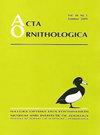美洲水貂新冠病毒入侵地区欧亚库特蟾蜍和大冠灰蝶繁殖种群的恢复
IF 1.3
4区 生物学
Q3 ORNITHOLOGY
引用次数: 3
摘要
在鸟类中,减轻捕食者影响的适应在面对引入的和迅速扩张的入侵的非本地捕食者时通常是无效的。因此,鸟类的数量往往在捕食者数量建立之后的一段时间内下降。研究了2002-2003年和2016年波兰东北部马祖里安湖区欧亚白骨顶和大冠Grebe Podiceps cristatus繁殖种群鸟类数量和鸟巢空间分布的变化,并参考了自20世纪90年代中期以来密度下降的美洲水貂的丰度进行了分析。这项研究是基于对繁殖对的普查和对31个湖泊的巢穴的搜索。繁殖白骨顶和灰顶鸟的数量分别增加了2.6倍和1.2倍。在这两个研究时期,格里布在人类住区和殖民地附近筑巢的倾向很强;然而,在定居点附近筑巢和在殖民地筑巢的灰鹭比例分别从51%下降到34%和从73%下降到57%。白骨顶也喜欢在人类居住区附近筑巢。白骨顶巢穴的分布并没有随着时间的推移而发生显著变化:在这两个时期,55-60%的白骨顶巢穴位于人类住区附近,13-19%位于Grebe殖民地。研究结果表明,白骨顶和大冠Grebe的繁殖种群可以应对入侵的美洲水貂,后者的捕食被认为是20世纪末马祖里安湖区水鸟数量减少的主要原因。本文章由计算机程序翻译,如有差异,请以英文原文为准。
Recovery of Eurasian Coot Fulica atra and Great Crested Grebe Podiceps cristatus Breeding Populations in an Area Invaded by the American Mink Neovison vison
In birds, adaptations that mitigate predators' impact are usually ineffective in confrontation with introduced and rapidly expanding invasive non-native predators. As a consequence, bird populations often decline in the period following the time when predator population is established. Changes in bird numbers and nest spatial distributions in breeding populations of the Eurasian Coot Fulica atra and Great Crested Grebe Podiceps cristatus were studied in Mazurian Lakeland, northeastern Poland in 2002–2003 and 2016, and were analyzed with reference to the abundance of invasive American Mink Neovison vison, whose density declined since mid 1990s. The study was based on a census of breeding pairs and a search of nests at 31 lakes. The numbers of breeding Coots and Grebes increased 2.6-fold and 1.2-fold, respectively. In both study periods Grebes displayed a strong tendency to nest in the vicinity of human settlements and in colonies; however, the percentage of Grebe pairs nesting near settlements and in colonies decreased from 51% to 34% and from 73% to 57%, respectively. Coots also preferred to nest in the vicinity of human settlements. Distributions of their nests have not changed significantly over time: in both periods 55–60% of Coot nests were found in close proximity to human settlements and 13–19% in Grebe colonies. The obtained results suggest that breeding populations of the Coot and Great Crested Grebe can cope with the invasive American Mink, whose predation was considered to be the main reason for waterbird declines in Mazurian Lakeland at the end of 20th century.
求助全文
通过发布文献求助,成功后即可免费获取论文全文。
去求助
来源期刊

Acta Ornithologica
生物-鸟类学
CiteScore
2.10
自引率
0.00%
发文量
14
审稿时长
>12 weeks
期刊介绍:
Publishes scientific papers (original research reports, reviews, short notes, etc.) and announcements from all fields of ornithology. All manuscripts are peer-reviewed.
Established in 1933 as Acta Ornithologica Musei Zoologici Polonici, since 1953 continued under the present title.
Published twice a year by the Natura Optima Dux Foundation under the auspices of the Museum and Institute of Zoology, Polish Academy of Sciences.
 求助内容:
求助内容: 应助结果提醒方式:
应助结果提醒方式:


